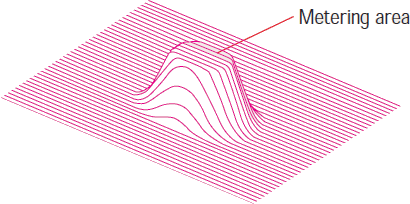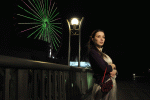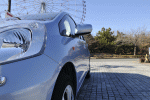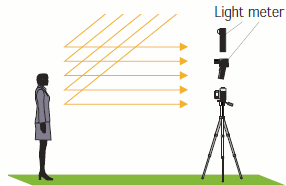Text begins from here.

 |
To take a photo of a subject
exactly as it is, or as you envision it, accurate measurement of the
light on and around the subject is vital. The measurement of this light
is called "photometry" or "metering." Cameras use built-in light
meters, which base their auto exposure values on meter information.
Some light meters can even switch to different metering modes to select
the optimal metering for a variety of scenes. |

Most light meters have
three metering modes, which select how metering is performed on the
subject. Additionally, some camera manufacturers have their
own "intelligent" metering systems.
own "intelligent" metering systems.
| Center-weighted metering | Spot metering | Multi-zone metering | |||
| While measuring the overall brightness of a scene, this method placesgreatest importance on the central section of the image. This method ispopular since the subject is often placed in the center of the scene. | Uses a small point in the center of the scene to meter exposure. This modeis useful when a subject and background have a large difference in levels oflight and shadow, or when you wish to capture only a portion of the subject. | Using the camera's light receptors for metering, the camera calculates thelight in each of the divided areas and determines the average exposure for the overall scene. Even when light and shadow sections are mixed in the subject, this method can produce an optimal exposure. | |||
 |
 |
 |
|||
| Useful scenes Useful when the subject is positioned in the center of the scene or when the overall scene is evenly lit. |
Useful scenes Useful when a subject and background have extreme differences in light and shadow or when you wish to capture only a section of the subject. |
Useful scenes Useful in scenes with bright backgrounds or with a large amount of contrast such as at sunrise, sunset or at nighttime. |
|||
 |
 |
 |
 |
 |
 |

| Built-in light meter | External light meter |
| Ordinarily, a camera uses a built-in light meter. Singlelens reflex cameras equipped with TTL (Through The Lens) metering can perform highly accurate exposure control since they measure the amount of light recorded on the film directly through the lens. Also, some compact cameras have a light meter window designed to calculate exposure. In both types of cameras, reflective light meters are used. | External
light meters have both light metering and guide functions, which
determine exposure by giving priority to either aperture or shutter
speed. External light meters are often necessary for medium- and
large-format cameras since many of them are not equipped with
a built-in light meter. External light meters are also essential for professional lighting. External light meters that can be used for both incidental light and reflected light are the most popular type of meters. |

| Incident light meter | Reflective light meter |
 |
 |
| Obtains a more precise exposure and is less susceptible to the reflective ratio of the subject's color, since the light striking the subject is metered directly. | Measures the light reflected from the subject and, regardless of whether the subject is white or black, selects an exposure that will turn it gray. This metering is convenient because metering can be performed from the camera. |
